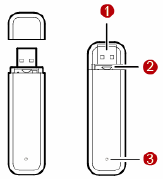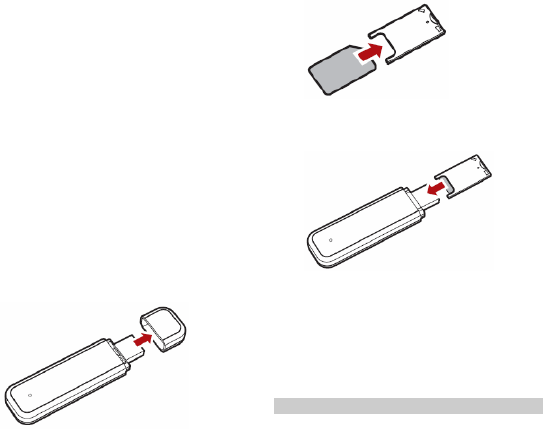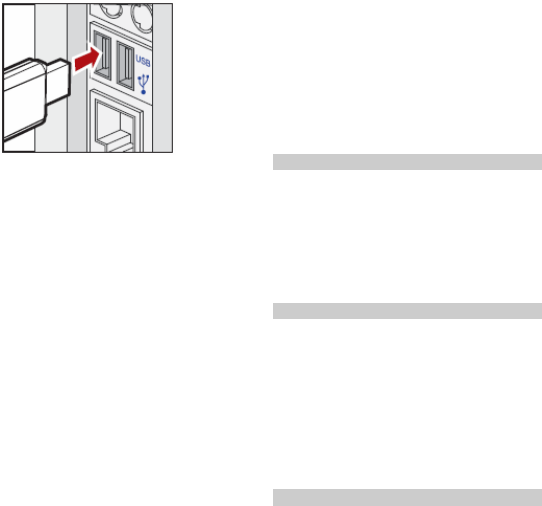Huawei Technologies EG162 GSM/GPRS/EDGE USB Stick User Manual
Huawei Technologies Co.,Ltd GSM/GPRS/EDGE USB Stick
User Manual

Copyright © 2007 Huawei Technologies Co., Ltd.
All Rights Reserved
No part of this manual may be reproduced or transmitted in any form or by any means
without prior written consent of Huawei Technologies Co., Ltd.
Trademarks
and HUAWEI are trademarks of Huawei Technologies Co., Ltd. All other
trademarks mentioned in this manual are the property of their respective holders.
Notice
The information in this manual is subject to change without notice. Every effort has been
made in the preparation of this manual to ensure accuracy of the contents, but all
statements, information, and recommendations in this manual do not constitute the
warranty of any kind, expressed or implied.
Table of Contents
Getting to Know the EG162....................................................................................1
Requirements for the PC..........................................................................................1
Preparing the EG162 ...............................................................................................2
Installation Guide.....................................................................................................2
Safety Information...................................................................................................4
i

Thank you for purchasing Huawei EG162
USB Stick (hereinafter referred to as the
EG162).
Note:
y This manual briefs the profiles of EG162,
including the preparation,
installation/uninstall process, and safety
precautions.
y You are highly recommended to read the
manual before using the EG162.
y The actual signal strength and the
transmission rate are affected by the
environment. If the singal stength is weak
when you use the USB Stick, you can move
the PC, or use the delivery-attached data
cable move the USB Stick.
Getting to Know the EG162
This is a sketch for EG162. The actual product
may differ.
1. USB connector
Connects to the USB interface of the PC.
2. SIM card slot
Fixes and bear the SIM card.
3. Indicator
It indicates the status of the EG162.
y Green, blinking twice every 3s: The EG162
is powered on.
y Green, blinking twice every 3s: The EG162
is registered to a GSM/GPRS/EDGE
network.
y Green, always on: The GSM/GPRS/EDGE
connection is set up.
y Blue, always on: SIM card is not installed.
SIM card is invalid. PIN code is required.
y Blue, blinking twice every 3s: The EG162
fails to search the network.
y Off: The EG162 is offline or removed from
a laptop.
Requirements for the PC
Before using the EG162, configure the
computer according to the following
requirements.
y USB interface: USB 2.0 full speed
y CPU: 866 MHz Pentium or above
y Memory: 128 MB or above
y Free space on the hard disk: 100 MB or
above
1

y Operating system: Windows XP, Windows
2000 or Window Vista
y Screen resolution: 1024 × 768 is
recommended.
Note:
y Improper configurations may degrade the
wireless device performance. Make sure that
the computer configurations meet the
requirements.
y For Windows XP, it is recommended to
install patches such as Service Pack 2 or
above.
y For Windows 2000, it is recommended to
install patches such as Service Pack 4 or
above.
Preparing the EG162
1. Press the right and left side of the cover,
and Remove it, take out the SIM card
slot.
2. Insert the SIM card into the card slot,
with the contact area on the card is facing
down and the beveled corner on the card
is facing inwards. Make sure that the
SIM card is fully in place.
3. Insert the card slot with the SIM card
into the EG162.
Installation Guide
The procedure for installing the management
program is subject to the operating system
installed on your laptop. The following section
takes Windows XP as an example.
Installing the EG162
1. Connect the EG162 to the USB interface
of the computer..
2

2. The driver runs automatically.
The Welcome interface is displayed.
Note:
y If the driver does not run automatically,
double-click My Computer. Then
double-click Mobile Partner CD-ROM
to install the driver. Alternatively, open
My Computer > Mobile Partner. Then
double-click Autorun.exe to install it.
y If there is more than one language, the
Installer Language interface is
displayed.
Select a language and click OK.
3. Click Next.
The License Agreement interface is
displayed.
4. Read the license agreement carefully. If
you agree with the license agreement,
select I agree….
The Choose Install Location interface is
displayed.
5. Choose the install directory and click
Next.
The Choose Start Menu Folder
interface is displayed.
6. Choose or create the start menu folder
and click Install.
Mobile Partner is installed.
7. Click Finish to complete the installation.
Launching the Mobile Partner
After the EG162 is installed, Mobile Partner is
launched automatically. Then every time the
EG162 is connected to the PC, the Mobile
Partner is launched automatically.
You can double-click the shortcut icon of
Mobile Partner to launch it.
Uninstalling the Mobile Partner
1. Click Start Menu.
2. Click Control Panel.
3. Find the management program, and click
ll it.
Add/Remove Program to uninsta
Note: It is recommended to restart the
computer after the uninstall to ensure
that Mobile Partner is completely
cleared.
Removing the EG162
rtner.
1. Log out of Mobile Pa
2. Remove the EG162.
3

Safety Information
Please read the safety information carefully to
ensure the correct and safe use of your
wireless device.
General Recommendations for Use
Always handle your wireless device with care
and keep it in a clean and dust-free place. Do
not expose your wireless device to open
flames or lit tobacco products.
y Always keep your wireless device dry.
y Do not drop, throw or try to bend your
wireless device.
y Do not paint or scratch your wireless device.
y Do not attempt to disassemble your wireless
device. Doing so will void warranty. Only
authorized personnel are allowed to do so.
y This product requires a minimum distance
of 1.5 cm from the body when in operation.
y Keep your wireless device in normal
temperature. Your wireless device can only
operate between -5ºC and +55 ºC.
y Use approved accessories only. Do not
connect your wireless device to any
incompatible products.
Obey Laws and Regulations
Do not operate your wireless device where it
may be unsafe to do so or where you are
required not to do so.
To deactivate your wireless device, close all
applications using the wireless device first and
then remove the wireless device from your
PC.
Obey all local laws, regulations, rules, orders,
signs and notices while using the wireless
device. Signs about the use of mobile phones
should also be obeyed as referring to other
wireless equipment including wireless
devices.
Deactivate in Explosive Areas
Deactivate your wireless device where the air
is potentially explosive. It is rare, but your PC
could generate sparks.
Deactivate in Blasting Areas
Deactivate your wireless device where
blasting is in progress. Remote-controlled RF
devices are often used at construction sites to
set off blasting.
Deactivate in Aircrafts
Deactivate your wireless device before
boarding or in any aircraft. Wireless devices
can cause interference in aircrafts.
Deactivate at Hospitals
Obey regulations or rules at hospitals.
Deactivate your wireless device near medical
equipment. Wireless devices can cause
4

interference to cardiac pacemakers, implanted
defibrillators or other medical equipment.
Deactivate near Hearing Devices
Deactivate your wireless device near hearing
devices. People with hearing aids may
experience interfering noises near wireless
devices.
Recommendations for Children
Do NOT allow children to play with your
wireless device. They could hurt themselves
or others, or could accidentally damage the
wireless device. Your wireless device contains
small parts with sharp edges that may cause an
injury or a choking hazard.
Deactivate While Driving
Do not use the wireless device while driving.
Immunity to Interference
Your wireless device is immune to
interferences caused by audible signals.
Cleaning and Maintenance
y Before you clean or maintain the wireless
device, close all applications using wireless
device and remove your wireless device
from your PC.
y Clean your wireless device with a piece of
soft antistatic cloth.
y If the wireless device or any of its
accessories does not work, turn to an
authorized service center for help.
Environmental Protection
Observe the local regulations regarding the
disposal of your packaging materials, old
wireless device and its accessories. Please
promote their recycling.
SIM/USIM Cards
While inserting or removing the SIM card,
protect yourself against electrostatic discharge
(ESD). Do not touch the connector of the SIM
card. As a precaution, always make sure that
the wireless device is already in your hand
before you insert or remove the SIM card.
Restart on ESDs
Software will attempt to re-initialize a
connection once a substantial electrostatic
discharge causes the device to reset. If the
software is not operational after an ESD,
restart the modem software application.
Agency/Regulatory Information
The wireless device is approved for use in
many regions of the world. In these regions,
the device meets all radio frequency exposure
requirements. The following approvals and
notices apply in specific regions as noted.
5

CE Approval (European Union)
The wireless device is approved to be used in
the member states of the EU. Huawei declares
that the wireless device is in compliance with
the essential requirements and other relevant
provisions of the Radio and
Telecommunications Terminal Equipment
Directive 1999/5/EC (R&TTE Directive).
Radio Frequency Exposure
To ensure compliance at all times with the
R&TTE Directive* 1999/5/EC, the wireless
device can be held in the hand but still
requires a minimum distance of 1.5 cm from
the body when in operation. For body-worn
use, it must be suitably mounted so that it is at
least 1.5 cm away from the body. Mounting
accessories (for example, belt clips) cannot be
made of metal. Do not put the wireless device
in your pocket.
* The general public RF exposure limits
referenced in the R&TTE Directive are
consistent with the published Guidelines of
the International Commission on
Non-Ionizing Radiation Protection (ICNIRP)
1998. ICNIRP is a formally recognized
non-governmental organization in
Non-Ionising Radiation Protection for the
World Health Organisation (WHO), the
International Labour Organisation (ILO) and
the European Union (EU). For more
information, visit the ICNIRP website at
www.icnirp.de.
Certification Information (SAR)
THIS DEVICE MEETS THE
GOVERNMENT'S REQUIREMENTS FOR
EXPOSURE TO RADIO FREQUENCY
ELECTROMAGNETIC FIELD.
Your wireless device is a low-power radio
transmitter and receiver. When it is running, it
emits low levels of radio frequency energy
(also known as radio waves or radio frequency
fields).
Governments around the world have adopted
comprehensive international safety guidelines,
developed by scientific organizations, e.g.
ICNIRP (International Commission on
Non-Ionizing Radiation Protection) and IEEE
(Institute of Electrical and Electronics
Engineers Inc.), through periodic and
thorough evaluation of scientific studies.
These guidelines establish permitted levels of
radio wave exposure for the public. The levels
include a safety margin designed to assure the
safety of all persons, regardless of age and
health, and to account for any variations in
measurements.
Specific Absorption Rate (SAR) is the unit of
measurement for the amount of radio
frequency energy absorbed by the body when
using a wireless device. The SAR value is
determined at the highest certified power level
in laboratory conditions, but the actual SAR
level of the wireless device while operating
can be well below the value. This is because
the wireless device is designed to use the
6

minimum power required to reach the
network.
All models of Huawei’s wireless device are
designed to meet radio frequency exposure
guidelines such as European Council
Recommendation and Federal
Communications Commission Notice (United
States).
European Council Recommendation:
Before a wireless device model is available
for sale to the public, it must be tested
according to the technical standard-EN 50361
and not exceed the limit established by the
European Council Recommendation:
1999/519/EC for safe exposure.
The SAR limit adopted by the 1999/519/EC is
2.0 watts/kilogram (W/kg) averaged over ten
gram of tissue. The highest SAR value for this
device type when tested is 0.927 W/kg.
[EN 50361 scope states “This basic standard
applies to any electromagnetic field (EM)
transmitting devices intended to be used with
the radiating part of the equipment in close
proximity to the human ear including mobile
phones, cordless phones, etc. The frequency
range is 300 MHz to 3 GHz. Therefore, the
above text does not address primary use of the
wireless device product.]
Federal Communications Commission
Notice (United States): Before a wireless
device model is available for sale to the public,
it must be tested and certified to the FCC that
it does not exceed the limit established by the
government-adopted requirement for safe
exposure.
The SAR limit adopted by the USA and
Canada is 1.6 watts/kilogram (W/kg) averaged
over one gram of tissue. The highest SAR
value reported to the FCC and IC for this
device type when tested for use is 1.28 W/kg.
[There is no reference to the specific reference
standard or its applicability to the intended use
of the product]
FCC Statement
This equipment has been tested and found to
comply with the limits for a Class B digital
device, pursuant to Part 15 of the FCC Rules.
These limits are designed to provide
reasonable protection against harmful
interference in a residential installation. This
equipment generates, uses and can radiate
radio frequency energy and, if not installed
and used in accordance with the instructions,
may cause harmful interference to radio
communications. However, there is no
guarantee that interference will not occur in a
particular installation. If this equipment does
cause harmful interference to radio or
television reception, which can be determined
by turning the equipment off and on, the user
is encouraged to try to correct the interference
by one or more of the following measures:
7
y Reorient or relocate the receiving antenna.
y Increase the separation between the
equipment and receiver.
y Connect the equipment into an outlet on a
circuit different from that to which the
receiver is connected.
y Consult the dealer or an experienced
radio/TV technician for help.
This device complies with Part 15 of the FCC
Rules and with RSS-210 of Industry Canada.
Operation is subject to the following two
conditions: (1) this device may not cause
harmful interference, and (2) this device must
accept any interference received, including
interference that may cause undesired
operation.
Warning: Changes or modifications made to
this equipment not expressly approved by
HUAWEI may void the FCC authorization to
operate this equipment.
Version: V100R001_01
Part Number: 31018383
8